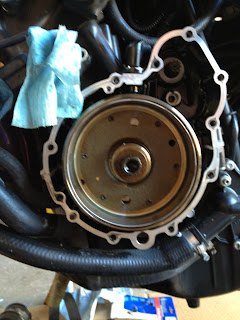 |
| That's one sexy rotor |
Cost savings aside - which were substantial in this case, a few hundred dollars at least - there is a great deal of value in pulling your bike apart, fixing the problem and then putting it all back together the right way.
For one thing, it takes a good deal of courage just to start the job if you don't already have experience working on mechanical things. I pulled a lawn mower engine apart and put it back together back in high school and I still get nervous before tackling a new repair. And the idea of checking the valve clearances on this bike makes me break into a cold sweat.
Next up, it forces you to be persistent. Especially when the bike is your main mode of transportation. Nothing ever goes smoothly, there's always a challenge of some sort. For example, rare is the repair that doesn't require removing other critical parts - hoses, the gas tank, a carburetor, etc. - in order to get to the broken one. After the troubleshooting, removing those bits is usually the most difficult part of the job. And then you've got to get them all back into place. A lack of persistence means a non-running bike (case in point, the VX800 languishing in my garage...).
Taking a closer look at the issue of parts you have to remove in order to get to the part you're interested: working on a motorcycle forces you to be careful and methodical. It's best to learn this lesson before you find yourself staring at a Ziploc bag containing a couple different springs, several bolts in varied sizes and a note that says "carb and fuel pump." You'll have a chance to learn this lesson again when you drop one of those bolts into some inaccessible part of the bike and spend an hour trying to fish it out with a flashlight and a wire clothes hanger.
Along the way, you'll get plenty of opportunities to practice your troubleshooting skills. Motorcycles are reasonably simple machines, but they're still made up of several systems that have to work together correctly in order to deliver the necessary air, fuel and spark the motor needs in order to run. Every system added increases the complexity a bit, and modern bikes have quite a few systems.
Which leads into the final point. To the uninitiated, a motorcycle may as well be a kitchen appliance, just like cars. It's a hunk of metal that does a particular thing. When it stops doing its particular thing, call a repair shop. For those of us in the know, a motorcycle is far more than an appliance, and deserves personal care and respect. Working on your own bike lets you get to know each system, and see how they work together. Ultimately, you end up with a much better understanding of how your bike works, which is a very good thing.
Especially when you finally run into something you can't/don't want to do and the mechanic tries to tell you the problem is that you're low on blinker fluid.
As in every situation, knowledge is power, and doing your own wrenching will increase your level of knowledge in a hurry. When you use the skills you developed (while trying to get your own infernal machine on the road again) to solve a problem for someone else, they will be impressed. Beers and high fives will be forthcoming, and you'll be glad for the bloody knuckles and frustration you endured trying to get that confounded oil filter loose.










0 comments:
Post a Comment